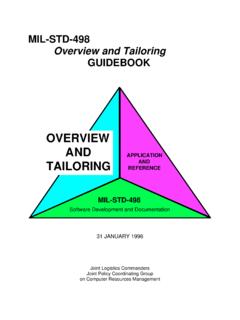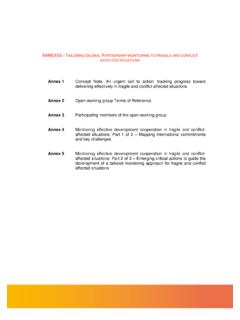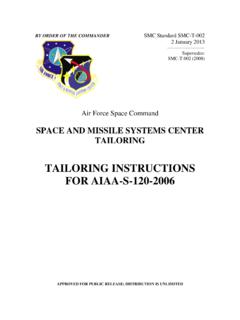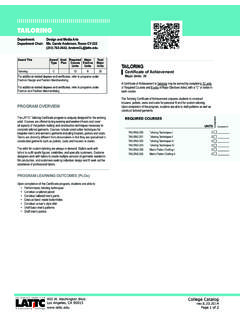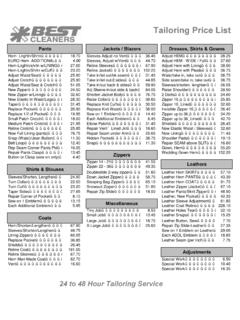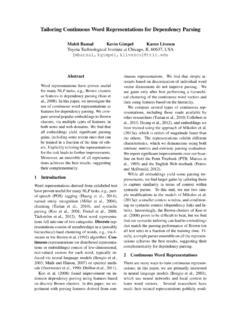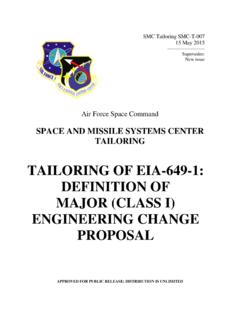Transcription of Project and Process Tailoring For Success - CQAA
1 1 Project and Process Tailoring For Success2 Key Learning Objectives Demonstrate how Project / Process Tailoring can decrease cost by aligning Process intensity with Project risk and complexity Provide a roadmap for implementing Tailoring within your software testing Process Demonstrate how Tailoring can leveraged by Testing organizations to streamline the planning and execution of software testing Illustrate how Process auditing and compliance coupled with Tailoring can facilitate the overall Quality Management process3 Cost of Correcting Defects020004000600080001000012000140001 6000 RequirementsDesignCodingTestingMaintenan ce4 The Situation Your organization is tasked with accomplishing a Process Common Approach Many organizations employ a one size fits all approach for executing tasks Applying the same Process , tools, and techniques to every task regardless of size, complexity and risk tolerance Alternative Approach Utilize an approach where Process Intensity is proportionate to the size.
2 Complexity and risk level of the project5 Introducing Project / Process TailoringTailoring is an approach where Process Intensity is proportionate to the size, complexity and risk level of the projectCommon Approach* Process Intensity = All of the processes, policies, templates, forms, checkpoints, procedures required to successfully deliver a compliant Project . Project Tailoring Approach6 Process Intensity vs. Project Complexity7 Testing AssetsTest PlanTesting StrategyRequirementsTest ScenariosMethodologiesDefect TrackingTest Schedule8 One Size Fits All ApproachSet of Assets Size Risk Methodology DomainProcessNeedRegardless of common factors that influence complexitythe same Process is always followed9 Tailoring A ProcessStandardProcessTailoredProcessPro cess AssetsEnvironmentalFactors Size Risk Methodology DomainMeets specific need10 Example.
3 Product VerificationVerify ApplicationFunctionalityProcessTest CasesTest ParmsStandardsEnvironmentalFactors Size Risk Methodology Domain COTS application Custom development Enterprise vs. departmental Platform Automation11 Standardization Standardization is the Process of developing and agreeing upon technical standards: A standard is a document that establishes uniform engineering or technical specifications, criteria, methods, processes, or practices. Some standards are mandatory while others are voluntary. Voluntary standards are available if one chooses to use them.
4 Some are de facto standards, meaning a norm or requirement which has an informal but dominant status. Some standards are formal legal requirements. 12 CMMI And Tailoring A defined Process is a managed Process that is tailored from the organization s set of standard processes according to the organization s Tailoring guidelines. Organizational guidelines enable Project teams, work groups, and organizational functions to appropriately adapt standard processes for their use. The organization s set of standard processes is described at a general level that may not be directly usable to perform a Process .
5 Tailoring guidelines aid those who establish the defined processes for Project or work groups. Tailoring guidelines cover: selecting a standard Process selecting an approved lifecycle model, and Tailoring the selected standard Process and lifecycle model to fit Project or work group needs. Tailoring guidelines describe what can and cannot be modified and identify Process components that are candidates for modification13 CMM And Tailoring Cont. Generic Practice -Establish a Defined Process Establish and maintain the description of a defined Process .
6 The purpose of this generic practice is to establish and maintain a description of the Process that is tailored from the organization s set of standard processes to address the needs of a specific instantiation. The organization should have standard processes that cover the Process area, as well as have guidelines for Tailoring these standard processes to meet the needs of a Project or organizational function. With a defined Process , variability in how the processes are performed across the organization is reduced and Process assets, data, and learning can be effectively shared.
7 The descriptions of the defined processes provide the basis for planning, performing, and managing the activities, work products, and services associated with the And Tailoring from the organization s set of standard processes those processes that cover the Process area and best meet the needs of the Project or organizational the defined Process by Tailoring the selected processes according to the organization s Tailoring that the organization s Process objectives are appropriately addressed in the defined the defined Process and the records of the the description of the defined Process as Organizations Need TailoringMany large organizations struggle with.
8 Gaining visibility into adherence with critical standards and regulations early-on in the Project lifecycle instead of at the end Process scale vs. rigor, how can we have Process that can handle all types of projects and yet provides an appropriate level of control and governance How to improve cross-functional teamwork and communication with the ultimate goal of increasing efficiency and Project velocity 16 The Problem Wont Go Away Most companies start out with the good intention of creating and standardizing on a single Process : This quest for uniformity and economies-of-scale quickly backfires Always need to create the same 20+ page requirements document Always needs to create the same 20+ page test plan Organizations are buried in Process related documents, checklists, templates Everything slows to a sluggish pace17 Top Reasons IT Projects FailInaccurateScheduleProject Manager not well-versed in necessary methodologies and lacks task-level expertiseInaccurateScheduleProcess is too complex, requires too much paperwork, too many meetings.
9 Too many sign-offsInaccurateScheduleQA involved too late in the Process and unclear expectations regarding compliance and audit requirementsSchedule missing critical tasksReach end and fail complianceMisalignment and finger-pointing on Project teamInaccurateScheduleInconsistent documentation, inadequate traceability and real-time analysis and reportingSymptomRoot-CauseTemplates, Reviews never completed18 How Tailoring Can Benefit An OrganizationTailoringREDUCES COSTCREATES REPEATABLE, PROVEN PROCESSESMITIGATES COMPLIANCE-RELATED RISKENABLES RISK-BASED TESTING19 Impact of Tailoring on Cost To Deliver By aligning Process intensity with Project risk and complexity, Tailoring can reduce demands for: Forms Checklists Processes Procedures Templates Can free valuable time for engineering and testing resources that can cause small projects to proceed at a sluggish pace.
10 On average, Tailoring can reduce Process intensity by 3X-6X which can equate to more than 20% savings in Project costs and other costs associated with standards, compliance and Project oversight. 20 Improve Repeatability Through Tailoring By creating a Process Standards Notebook of all of the processes, policies, templates and forms required Tailoring helps organizations define a repeatable, reproducible Process which eliminates the reinventing the wheel phenomenon associated with many projects. This approach helps organization achieve greater economies-of-scale and deliver projects in a more consistent, on-time Compliance-Related Risk Tailoring enables organizations to reduce risk associated with compliance by.
